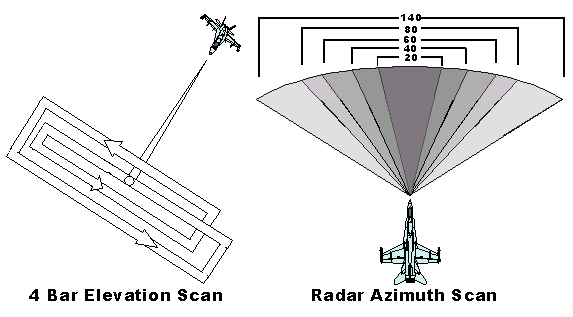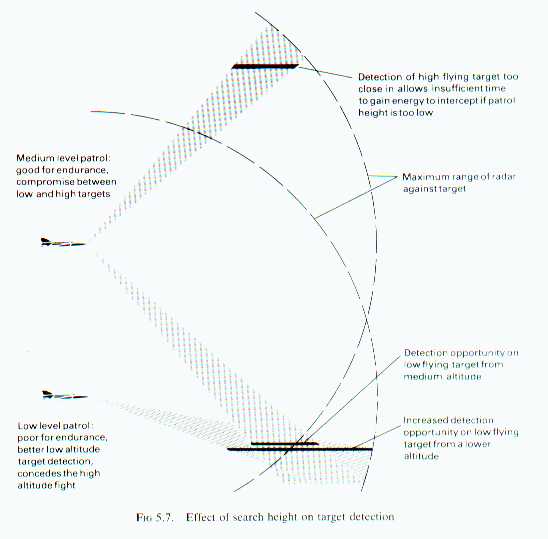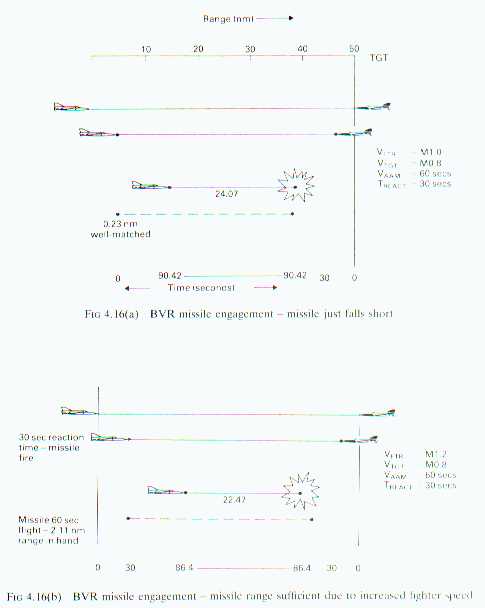- Search or Scan Volume - The area of the sky that the radar can scan. This is made up of range (distance), azimuth (horizontal), and elevation (vertical).
- Antenna Azimuth - Horizontal (width) scan of the radar antenna measured in degrees. One sweep of the antenna is called a bar. In hornet, the antenna can scan 20°, 40°, 60°, 80°, and 140° of area in front of the aircraft.
- Antenna Elevation - Vertical (height) scan of the radar antenna based on the number of bars selected. One bar is equal to about 2° of vertical scan. As you add more bars (up to 6-bars in F/A-18 Hornet), you add an additional 2° per bar, up to 12° of vertical scan volume. The figure below depicts a 4-bar scan.
- Range - The range of the radar in F/A-18 Hornet is about 80nm. Although you can change the range on the MFD, the radar actually maintains a 80nm scan range. You are only changing the visual measured range on the MFD.
- Range-While-Search (RWS) is best used for a general search mode, when there is not a specific bogey group you are looking for, and you have to cover a large sector of airspace. A wide azimuth and long range scale should be selected for optimum coverage while on Combat Air Patrol (CAP). RWS provides a good balance between long-range detection of head-on targets, and medium-range detection of targets near 90 degrees aspect.
- Track-While-Scan (TWS) is best used when you have committed on a specific bogey group and you can afford to lose wide-area coverage. This mode is used for it's superior update rates (it does a better job of maintaining track files), but it provides more Situational Awareness (SA) than Single-Target-Track (STT). You can keep track of several aircraft in a close formation, but you may lose track of widely spaced groups (which would normally be assigned to another section of fighters). AMRAAM shots should always be from TWS or STT.
- Velocity Search (VS) provides the longest-range detection of head-on targets only. This mode is fairly specialized and rarely used, unless there is specific information on what the threat aircraft are doing and there is little early-warning coverage (E-2 or AWACS).
- "Silent" is a mode in which the radar continues to scan and listen for electronic emissions, but does not transmit. This may be used to hide from enemy installations if they are using passive detection equipment to track your aircraft by listening to your radar emissions. You may still be able to detect other aircraft by the emissions from their radars, but you will only get bearing and elevation information, you cannot get their range. Occasionally switching between silent and active may give you some range information while maintaining a mostly-silent aircraft.
F/A-18 RADAR Modes & BVR Tactics
RADAR MODES
The radar set in F/A-18 Hornet is modeled after the Hughes AN/APG-65 in the F/A-18A & B models and the AN/APG-73 in the F/A-18C/D/E/F Models. Although The actual modes and sub-modes of the radar are accurate, and modelled to perfection. This is evident when you see a bandit on the RWR, and can lock him up well within range. The book does an excellent job of explaining the avionics, but here a few things to help clarify your understanding.
So that you understand the way radar works, let me explain the mechanics of it. Here are a few definitions.

There are several types of radar used today. Pulse-Doppler, Continuous Wave-Doppler, and a hybrid of both. I am not going to get too technical as that goes outside the scope of this module. But we will start with Pulse-Doppler, which most aircraft use today. Pulse-Doppler emits a radio beam (radio energy) in pulses. Pulse-Doppler also allows the use of one antenna to send and receive pulses. It does this by means of Frequency Modulation Ranging (FMR). Pulses are sent at different frequencies enabling the antenna to read returns between sends. FMR also gives the wave a distinct marker (the different frequencies) so that the radar can identify the type of wave and the time it sent the wave. When the beam hits a target, say another aircraft, the beam bounces back like light hitting a mirror. This is called a "return or return energy". The antenna collects the return and sends the signal to a computer for analysis. Using FMR, time sent, and wave intensity , the radar can determine the range and speed of the target. It can also assign certain frequencies to target aircraft for multiple target tracking. One strike against Pulse-Doppler is that the return from an approaching frontal target is usually weak (small radar cross section of an approaching target) and can fool or even hide the target. It allows pilot's to hide from the enemy radar so that he can approach without detection. The AN/APG-65 is based on this type of radar model except for the "notch".
The other type used in older soviet aircraft, SAMs, and early warning radar is Continuous Wave-Doppler (CW). CW requires two antennas, one to send and one to receive. As the name states, CW sends a continuous wave of radar energy. This type of radar uses Doppler-Effect Ranging (DER). As the target approaches, a shift in the frequency is made in the return signal to the receive antenna. This is called a doppler-shift. Anything that approaches the radar head on creates a doppler-shift, but fly 90° or abeam to the radar and no shift is produced. This can be overcome with a more powerful radar, but not usually with aircraft radars of this type.
To understand the differences of the sub-modes of the AN/APG-65 radar, let start out with, a hornet pilot from the Navy Test Pilot School (NTPS) who gives a brief explanation on each sub-mode and what they are best suited for:
In the Hornet, we use Range-While-Search (RWS) almost exclusively for target acquisition. In the game, you are much better served to use Track-While-Scan (TWS). Even more in depth, we usually use the AMRAAM set. This involves a 4Bar, 80nm, 80 degree RWS scan.
During close in combat, the ACM modes of operation should be used. This gives you an automatic 10nm range with a specific scan pattern. It also allows for auto-lock up of the closest indicated treat (make sure that your wingman isn't the closest target!). ACM modes are NOT gimbaled to the horizon. This allows pointing the nose of the aircraft AND the radar scan in the direction of the bogey no matter what the angle or AOA of the aircraft. ACM mode is made up of WACQ, VACQ, GACQ, and BST (boresight). I suggest you use VACQ for your ACM mode during close in combat. If you have a problem locking on to a target in WACQ (wide mode), VACQ (vertical mode), or GACQ (gun mode), switch to BST. This will force the antenna into a tighter scan pattern enabling you to lock the bogey up quicker. Use BST only if you have the bogey in front of you and you have an immediate firing solution.
The information above should make using the RADAR system a little easier. Remember, RWS or TWS for CAP / Escort missions where long range and quicker detection is needed, TWS for sorting, target hand-off, and A2A weapons deployment, STT for A2A weapons deployment, and ACM modes for close in combat. There is more to come on this subject.
BVR Tactics

